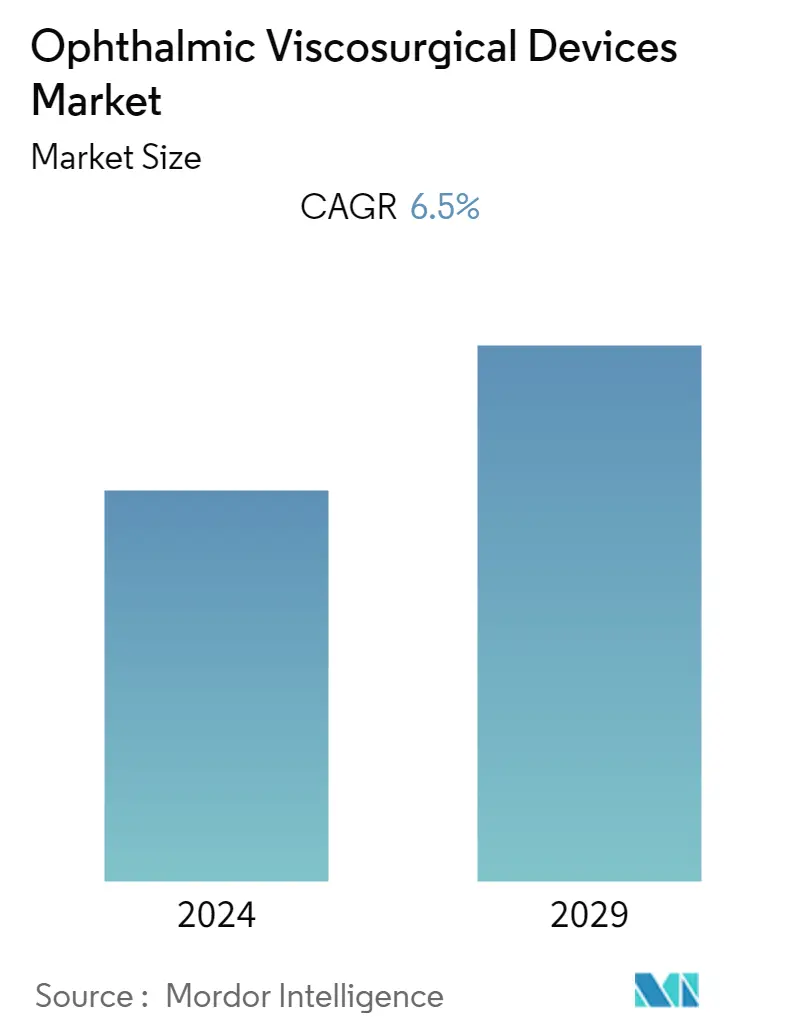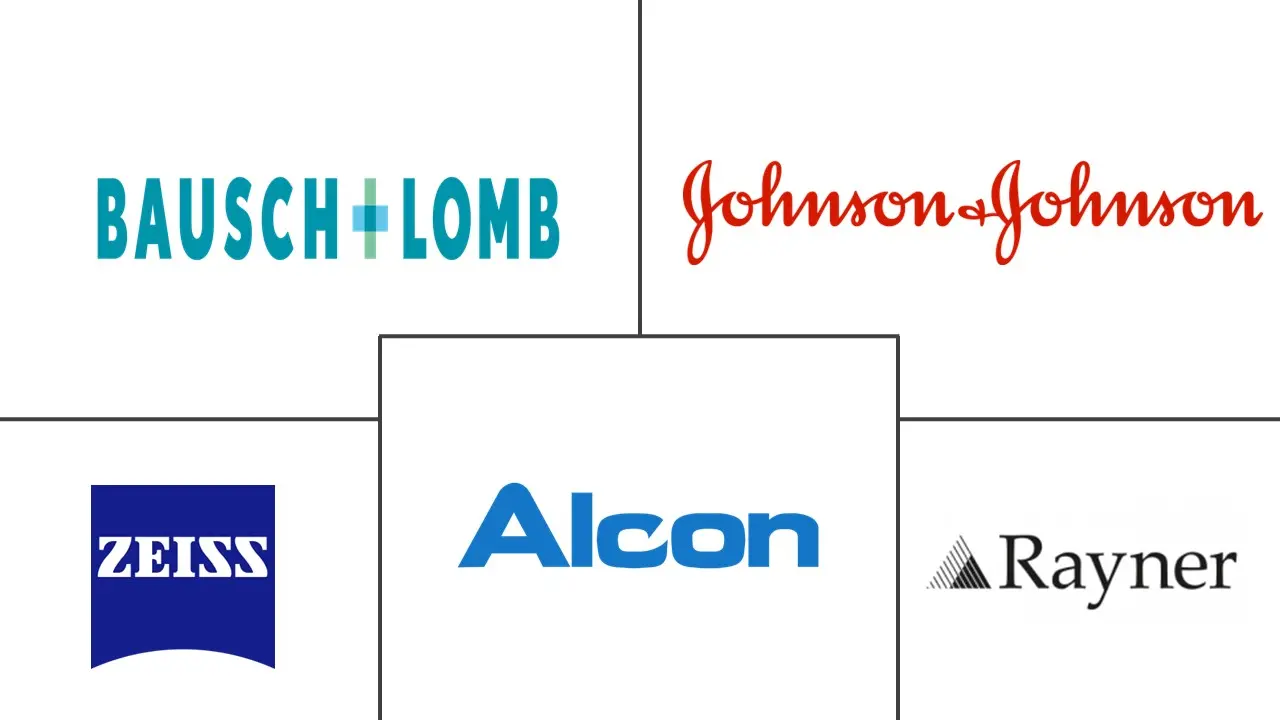Market Size of Ophthalmic Viscosurgical Devices Industry

| Study Period | 2019 - 2029 |
| Base Year For Estimation | 2023 |
| CAGR | 6.50 % |
| Fastest Growing Market | Asia-Pacific |
| Largest Market | North America |
| Market Concentration | Medium |
Major Players
*Disclaimer: Major Players sorted in no particular order |
Ophthalmic Viscosurgical Devices Market Analysis
The ophthalmic viscosurgical devices market is expected to register a CAGR of 6.5% during the forecast period.
Initially, with the increasing COVID-19 cases around the world, governments around the globe implemented lockdown measures to stop the spread of the SARS-CoV-2 virus, which not only led to a drop in footfall in clinics and hospitals for eye care but also led to the cancellation or postponement of many procedures which had its impact on the patients as well as the studied market. For instance, according to a research study published by Parul C Gupta et al. in 2021 in the Indian Journal of Ophthalmology, the studied clinic was expected to perform 7,500 cataract procedures. Still, due to the pandemic, they could serve only 2,500 procedures. This data suggested a significant decrease in cataract procedures during the COVID-19 pandemic. As per the research study published by Gabriel Ayubet. al., in November 2021, on the comparison of the pre-pandemic and pandemic periods data for glaucoma patients in a tertiary center, it was observed the total number of outpatient clinical visits, visual field exams, surgical procedures, and medications released decreased by 92.52%, 93.84%, 72.74%, and 19.63%, respectively. This data shows a negative impact of COVID-19 on diagnosing and treating ocular disorders; thus, the market suffered negatively. Moreover, the market has been making a strong comeback since the limitations were lifted and normalized the supply chain. Increased outpatient visits and the removal of all restrictions on ophthalmic procedures have been driving the market recovery over the projected period.
This is attributed to the rapidly increasing geriatric population, increasing prevalence of diabetes, and an increasing number of cataract and glaucoma surgeries performed. The rising geriatric population worldwide is more prone to ocular disorders. For instance, the data published in October 2021 by the World Health Organization (WHO) reported that the pace of population aging is much faster than in the past, and by 2030, 1 in 6 people in the world will be aged 60 years or over. The share of the population aged 60 years and over will increase from 1 billion in 2020 to 1.4 billion by 2030. Thus, an increase in the geriatric population is expected to boost market growth over the forecast period.
Diabetes can damage the eyes, resulting in vision problems or even blindness. People with diabetes may experience various eye issues known as diabetic eye disease. These ailments include glaucoma, cataracts, diabetic macular, and diabetic retinopathy, and thus growing prevalence of diabetes is expected to cause eye diseases, thereby boosting the market growth. For instance, according to the IDF Diabetes Atlas Tenth Edition 2021, diabetes has affected around 537 million persons (20-79 years) in 2021 across the world. Diabetes is expected to affect 643 million people by 2030 and 783 million by 2045. Thus, the increasing prevalence of diabetes, the most common cause of ophthalmic disease, is expected to boost the market over the forecast period.
However, the availability of alternative procedures may hamper the market growth.
Ophthalmic Viscosurgical Devices Industry Segmentation
As per the scope of the report, ophthalmic viscosurgical devices are used in several ocular surgeries to guard the delicate ocular structure and to maintain space in the anterior chamber of an eye, leading to faster and safer surgery. These devices are composed of sodium hyaluronate, chondroitin sulfate, and hydroxypropyl methylcellulose. The market is segmented by type (cohesive, dispersive, and viscoadaptive), source (biological, animal, and semi-synthetic), application (glaucoma surgery, cataract surgery, corneal grafting, and other applications), and geography (North America, Europe, Asia-Pacific, Middle East and Africa, and South America). The report also covers the estimated market sizes and trends for 17 countries across major regions globally. The report offers the value (in USD million) for the above segments.
| By Type | |
| Cohesive | |
| Dispersive | |
| Viscoadaptive |
| By Source | |
| Biological | |
| Animal | |
| Semi-synthetic |
| By Application | |
| Glaucoma Surgery | |
| Cataract Surgery | |
| Corneal Grafting | |
| Other Applications |
| By Geography | ||||||||
| ||||||||
| ||||||||
| ||||||||
| ||||||||
|
Ophthalmic Viscosurgical Devices Market Size Summary
The ophthalmic viscosurgical devices market is poised for significant growth, driven by a combination of demographic and health trends. The market is recovering from the setbacks caused by the COVID-19 pandemic, which had led to a substantial decline in eye care procedures due to lockdowns and restrictions. As these limitations have been lifted, the market has seen a resurgence, fueled by increased outpatient visits and a normalization of the supply chain. The growing geriatric population, coupled with the rising prevalence of diabetes, is expected to further propel market expansion. These factors contribute to a higher incidence of ocular disorders, necessitating more cataract and glaucoma surgeries, which in turn drives the demand for ophthalmic viscosurgical devices.
North America is anticipated to maintain a significant share of the global market, supported by an aging population and robust healthcare infrastructure. The region's market growth is further bolstered by increased healthcare expenditure and improved access to ophthalmic care facilities. The prevalence of ophthalmic diseases, exacerbated by chronic conditions like diabetes, is a key driver of market demand. Additionally, strategic initiatives by major market players, including product launches and regulatory approvals, are expected to enhance market dynamics. The competitive landscape is characterized by the presence of several leading companies, such as Johnson & Johnson, Carl Zeiss Meditec AG, and Bausch & Lomb Incorporated, which continue to innovate and expand their offerings in the ophthalmic viscosurgical devices sector.
Ophthalmic Viscosurgical Devices Market Size - Table of Contents
-
1. MARKET DYNAMICS
-
1.1 Market Overview
-
1.2 Market Drivers
-
1.2.1 Rapidly Increasing Geriatric Population
-
1.2.2 Increasing Prevalence of Diabetes
-
1.2.3 Increasing Number of Cataract and Glaucoma Surgeries Performed
-
-
1.3 Market Restraints
-
1.3.1 Availability of Alternative Treatment Procedures
-
-
1.4 Porter's Five Forces Analysis
-
1.4.1 Threat of New Entrants
-
1.4.2 Bargaining Power of Buyers/Consumers
-
1.4.3 Bargaining Power of Suppliers
-
1.4.4 Threat of Substitute Products
-
1.4.5 Intensity of Competitive Rivalry
-
-
-
2. MARKET SEGMENTATION (Market Size by Value - USD Million)
-
2.1 By Type
-
2.1.1 Cohesive
-
2.1.2 Dispersive
-
2.1.3 Viscoadaptive
-
-
2.2 By Source
-
2.2.1 Biological
-
2.2.2 Animal
-
2.2.3 Semi-synthetic
-
-
2.3 By Application
-
2.3.1 Glaucoma Surgery
-
2.3.2 Cataract Surgery
-
2.3.3 Corneal Grafting
-
2.3.4 Other Applications
-
-
2.4 By Geography
-
2.4.1 North America
-
2.4.1.1 United States
-
2.4.1.2 Canada
-
2.4.1.3 Mexico
-
-
2.4.2 Europe
-
2.4.2.1 Germany
-
2.4.2.2 United Kingdom
-
2.4.2.3 France
-
2.4.2.4 Italy
-
2.4.2.5 Spain
-
2.4.2.6 Rest of Europe
-
-
2.4.3 Asia-Pacific
-
2.4.3.1 China
-
2.4.3.2 Japan
-
2.4.3.3 India
-
2.4.3.4 Australia
-
2.4.3.5 South Korea
-
2.4.3.6 Rest of Asia-Pacific
-
-
2.4.4 Middle East and Africa
-
2.4.4.1 GCC
-
2.4.4.2 South Africa
-
2.4.4.3 Rest of Middle East and Africa
-
-
2.4.5 South America
-
2.4.5.1 Brazil
-
2.4.5.2 Argentina
-
2.4.5.3 Rest of South America
-
-
-
Ophthalmic Viscosurgical Devices Market Size FAQs
What is the current Ophthalmic Viscosurgical Devices Market size?
The Ophthalmic Viscosurgical Devices Market is projected to register a CAGR of 6.5% during the forecast period (2024-2029)
Who are the key players in Ophthalmic Viscosurgical Devices Market?
Carl Zeiss Meditec AG, Bausch & Lomb Incorporated, Rayner Intraocular Lenses Limited, Alcon AG and Johnson & Johnson are the major companies operating in the Ophthalmic Viscosurgical Devices Market.

